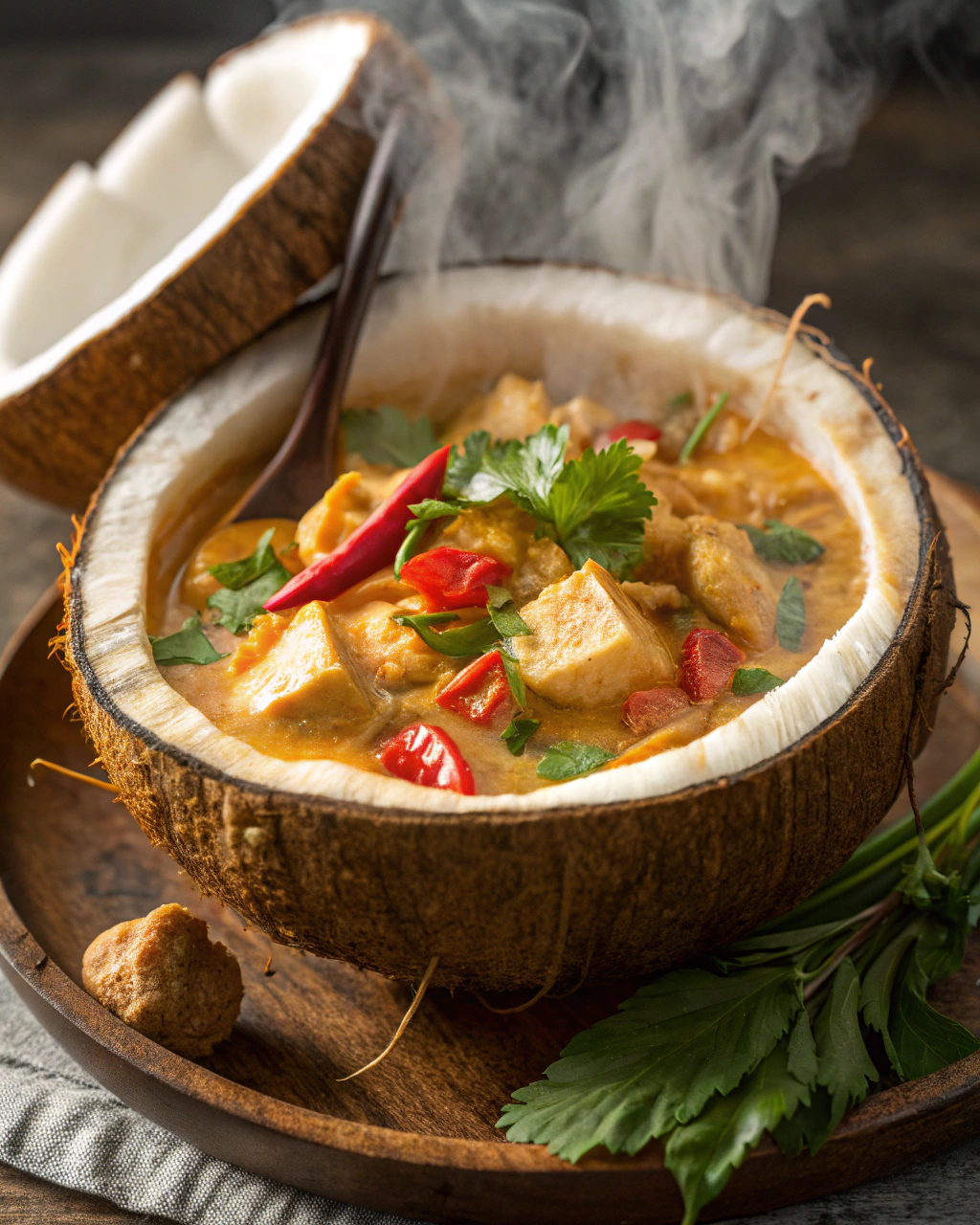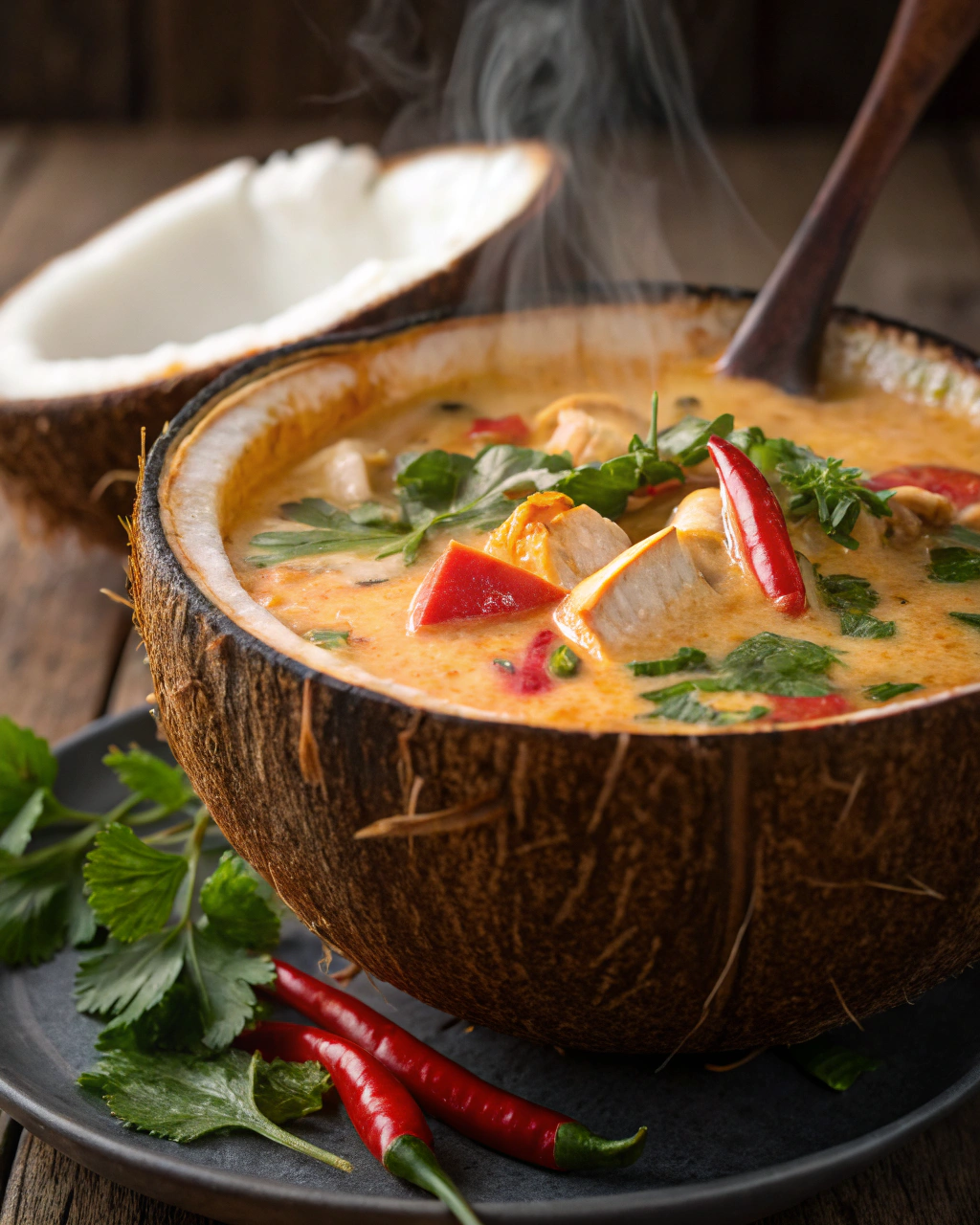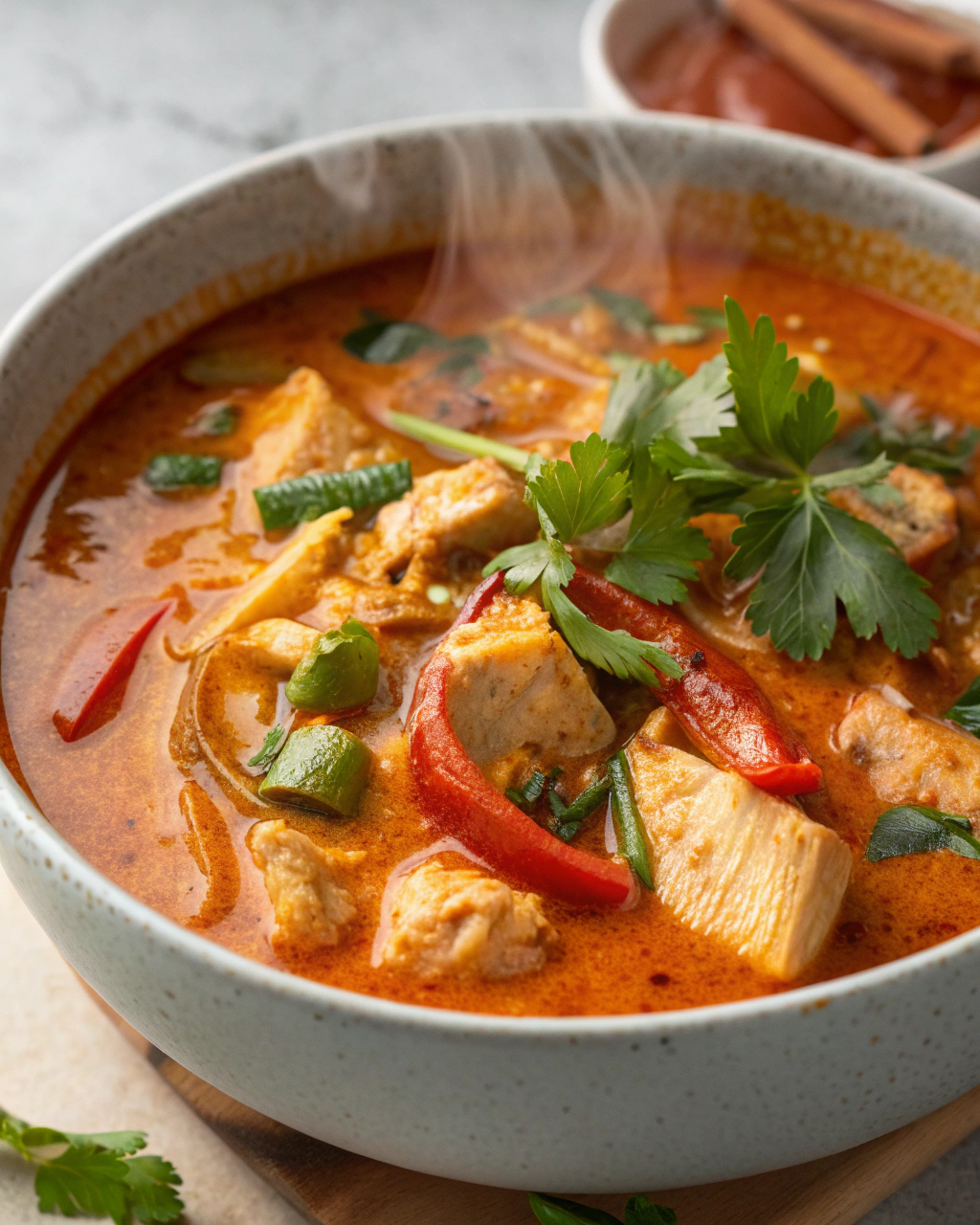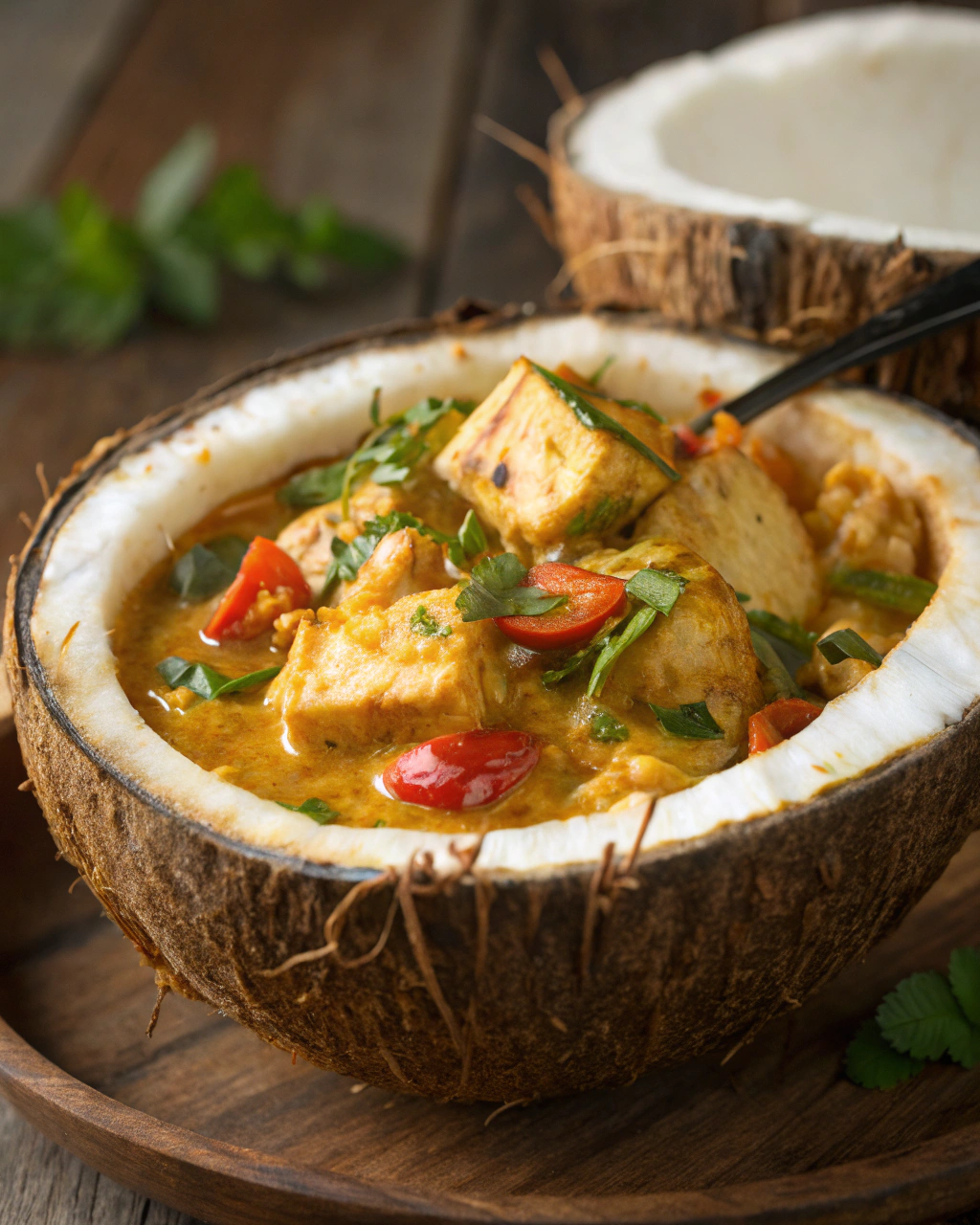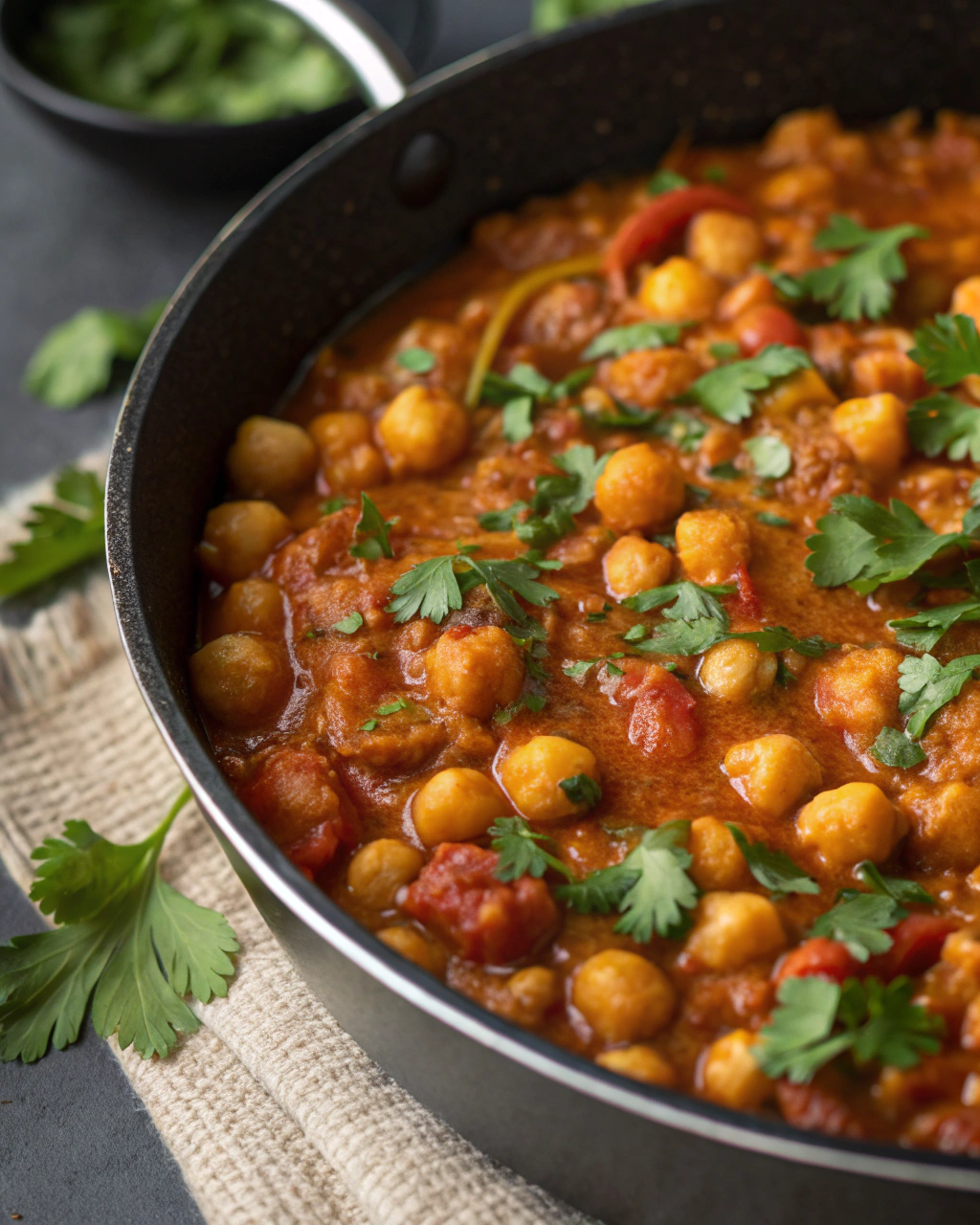Chef’s Secret: I’ll let you in on a tiny kitchen crime: a spoonful of store-bought curry paste plus a splash of coconut cream makes everyone ask if you labored all day. I stumbled on this trick during a frantic weeknight when I had three hungry people and zero time — and now I keep a jar of **red curry paste** like a tiny superhero in my pantry. This Thai-style coconut chicken curry smells like caramelized garlic and lime the moment it hits the pan, and it finishes in under an hour. Follow my shortcuts and you’ll get rich, silky sauce, colorful veggies, and tender chicken without sacrificing flavor. Ready to feel fancy with minimal effort?
Quick Facts
- Yield: Serves 4
- Prep Time: 15 minutes
- Cook Time: 25 minutes
- Total Time: 40 minutes
Why This Recipe is Awesome
This curry makes you look like a weekday wizard. The sauce stays luxuriously creamy from **full-fat coconut milk**, the curry paste gives it a bright, aromatic kick, and quick searing locks in juicy chicken flavor — hello, golden edges and sizzling pan music. Texture plays lovely tricks here: silky coconut sauce, tender chicken bites, and crisp-tender bell peppers. It’s reliable, forgiving, and ridiculously comforting. Honestly, it’s so easy even your oven can’t mess it up.
Ingredients
For the Main Dish:
- 1 1/2 lbs boneless, skinless chicken thighs, trimmed and cut into 1-inch pieces (you can use breasts if you prefer)
- 1 tbsp neutral oil (vegetable, canola, or light olive oil)
- 1 medium yellow onion, thinly sliced
- 3 cloves garlic, minced
- 1 tbsp fresh ginger, grated
- 2 tbsp red curry paste (adjust to taste)
- 1 (14 oz) can full-fat coconut milk
- 1/2 cup low-sodium chicken broth (or water)
- 1 tbsp fish sauce (or low-sodium soy sauce)
- 1 tbsp brown sugar or palm sugar
- 1 red bell pepper, sliced into thin strips
- 1 cup snap peas or green beans, trimmed
- Juice of 1 lime (about 2 tbsp)
- Salt and freshly ground black pepper, to taste
- Cooked jasmine rice, for serving
For the Sauce / Garnish (if applicable):
- Fresh cilantro, chopped (optional)
- Thai basil leaves (optional)
- Thinly sliced red chili or red pepper flakes for heat (optional)
- Wedge of lime for serving
How I Make It
Step 1:
Pat the chicken dry with paper towels and season lightly with salt and pepper. Heat a large skillet over medium-high heat with 1 tbsp oil. When the oil shimmers, add the chicken in a single layer and let it brown without fussing — you want those golden edges, about 3–4 minutes per side. Sear in batches if necessary so the pan doesn’t overcrowd. The sizzle and little brown bits will smell amazing and form the flavor base.
Step 2:
Remove the chicken to a plate. Reduce heat to medium and add the sliced onion. Sauté until soft and slightly translucent, about 4 minutes. Add the minced garlic and grated ginger and stir until fragrant — about 30 seconds. Spoon in the red curry paste and let it toast for another 30–45 seconds while stirring; you should smell the curry oils bloom (hello, warm, spicy perfume!).
Step 3:
Pour in the coconut milk and chicken broth, scraping up those brown bits with your spoon. Add the fish sauce and brown sugar, then return the chicken to the pan. Bring the sauce to a gentle simmer and cook for about 10 minutes so flavors meld and the sauce thickens slightly. Listen for a soft, steady simmer and watch the sauce develop a glossy, rosy color.
Step 4:
Stir in the sliced bell pepper and snap peas (or green beans). Simmer another 3–5 minutes until the veggies stay bright and crisp-tender and the chicken reaches an internal temperature of 165°F. Taste and adjust with salt, extra fish sauce, or a squeeze of lime if it needs brightness. The finished sauce should coat the back of a spoon — not watery, not gluey.
Step 5:
Remove from heat and stir in the lime juice. Scatter chopped cilantro and Thai basil over the top if you like. Serve hot over steamed jasmine rice with extra lime wedges on the side. Break a piece of crusty bread for mopping if you’re feeling decadent — that sauce deserves it.
Pro Tips
- Use full-fat coconut milk for the creamiest result; the low-fat versions can separate and taste thin.
- When searing chicken, don’t move it too soon — let it develop a golden crust for the best texture and flavor.
- Toast the curry paste briefly with the aromatics to deepen the flavor — it transforms canned paste from “ok” to “wow.”
- If your curry gets too thick after refrigeration, loosen with a splash of warm water or broth while reheating.
Common Mistakes to Avoid
- Skipping preheating: Classic rookie move. It changes texture and bake time.
- Overmixing: Leads to dense or chewy results. Mix until just combined.
- Guessing cook time: Always use visual cues or a timer, not just vibes.
- Overcrowding pans: Give your food some breathing room to crisp properly.
Alternatives & Substitutions
- Swap chicken for firm tofu (press and pan-fry first) for a vegetarian version — the sauce clings just as well but the texture changes to silky and hearty.
- Replace fish sauce with tamari or soy sauce for a vegetarian/vegan-friendly option (adds saltiness but loses the anchovy tang).
- Use coconut cream if you want an ultra-rich sauce; thin with water or broth if it feels too heavy.
- Gluten-free? Use gluten-free soy sauce or tamari and double-check your curry paste label.
Variations & Tips
- Make it spicy: add sliced Thai chiles, a teaspoon of chili garlic sauce, or extra curry paste.
- Kid-friendly: reduce curry paste to 1 tbsp and omit chiles, add a splash more coconut milk for mellow sweetness.
- Hearty veggie boost: add cubed sweet potatoes or baby potatoes with the broth and simmer until tender.
- Peanut twist: stir in 2 tbsp smooth peanut butter for a nutty, satay-like nuance.
- Quick weeknight changeup: swap chicken for pre-cooked shredded rotisserie chicken — add at the end just to heat through.
- Creative twist: finish with a teaspoon of lime zest for a perfume-like pop.
FAQ (Frequently Asked Questions)
- Can I make this ahead of time?
- Yes! Prepare the curry up to 2 days ahead and store in an airtight container in the fridge. Reheat gently on the stove over medium-low, adding a splash of water or broth to loosen the sauce. The flavors often deepen overnight.
- Can I double the recipe?
- Sure thing. Use a larger pot or Dutch oven and brown the chicken in batches so you don’t steam it. You may need to simmer a few extra minutes to bring the sauce together.
- Can I substitute butter with oil?
- Technically yes, but you’ll miss that buttery magic. Use ¾ the amount of oil.
- How do I know it’s done?
- The chicken should reach 165°F in the thickest part, have no pink in the center, and the sauce should coat the back of a spoon. Vegetables should remain bright and slightly crisp.
- What if I don’t have ingredient X?
- If you don’t have fresh ginger, use 1/2 tsp ground ginger in a pinch. No bell pepper? Swap in zucchini or carrots. No curry paste? blend 1 tbsp tomato paste + 1 tsp chili powder + 1/2 tsp cumin as a very rough substitute.
How I Like to Serve It
I usually spoon this curry over steaming jasmine rice and scatter cilantro and Thai basil on top. For crunchy contrast, I add a quick cucumber salad or sliced raw red onion. This dish shines at weeknight dinners but also deserves a casual dinner party — pair with a crisp Riesling or an icy lager. It brightens gray nights and makes summer nights taste tropical.
Notes
- Store leftovers in the fridge up to 3 days. Freeze for up to 2 months in a freezer-safe container.
- Safe internal temperature for chicken: 165°F. Reheat gently to avoid breaking the coconut emulsion.
Final Thoughts
Closing: Give this one a try — it’s cozy, quick, and full of personality. Now go impress someone — or just yourself — with your homemade masterpiece!

Hi, I’m Lina, the creator of Lina Easy Recipes.Cooking has always been my passion, and I love sharing simple, homemade dishes that anyone can prepare.
Love What You See?
Join me on Pinterest and Facebook for daily cooking inspiration, new recipe ideas, and behind-the-scenes kitchen stories. Let’s cook something wonderful together!

